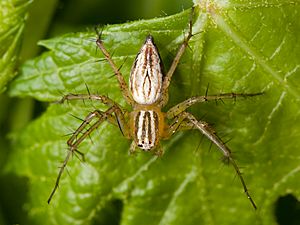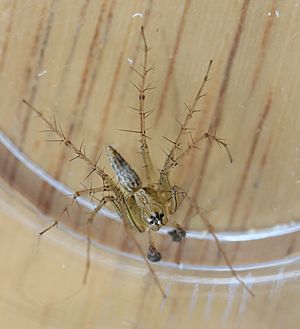Oxyopes salticus facts for kids
Quick facts for kids Oxyopes salticus |
|
|---|---|
 |
|
| Female O. salticus from Nashville, Tennessee | |
 |
|
| Male O. salticus from Hilo, Hawaii | |
| Scientific classification | |
| Genus: |
Oxyopes
|
| Species: |
salticus
|
| Synonyms | |
|
O.astutus |
|
The Oxyopes salticus is a cool type of lynx spider. Many people call it the striped lynx spider because of the stripes on its body. This spider was first described by a scientist named Hentz in 1845. You can usually find these spiders living in grassy areas or on leafy plants. They love places like weedy fields and farm crops.
Contents
What Does the Striped Lynx Spider Look Like?
Adult striped lynx spiders can be different colors. They might be orange, cream, or brown. Female spiders usually have stripes on their main body part (called the carapace) and their back part (called the abdomen). The stripes are often easier to see on their abdomen.
These spiders also have a special diamond-shaped mark on their back. Their legs (all four pairs!) are covered in stiff hairs called macrosetae. They also have a wide area below their eyes, which is called a clypeus.
Female O. salticus spiders are usually about 5 to 6 millimeters long. Male spiders are a bit smaller, typically 4 to 5 millimeters long.
Where Do Striped Lynx Spiders Live?
You can find the O. salticus spider in many places. In the eastern United States, they live from Massachusetts and Iowa all the way south to Florida and Texas. They also live along the Mexican border and up the Pacific coast to Oregon.
These spiders are also common in much of South America and Central America. Recently, many O. salticus spiders have been found on the Big Island of Hawai'i and the island of Maui.
How Striped Lynx Spiders Help Farmers
Striped lynx spiders are very important helpers for farmers! They are known as major predators of insects that can harm crops. These harmful insects are often called "agricultural pests."
For example, in 1961, a scientist in Japan released many Oxyopes sertatus spiders into a forest. He found that the spiders helped reduce damage from a tiny insect called a gall midge by 53%. Other studies in India have shown similar good results.
However, it's also important to know that O. salticus spiders sometimes eat helpful insects too. This includes insects like bees, which are important for pollinating plants. So, while they are great pest controllers, their role in farming is still being studied.
Gallery
See also
 In Spanish: Oxyopes salticus para niños
In Spanish: Oxyopes salticus para niños






